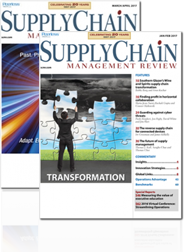Does Supply Chain Ever Apply To The Service Industry
By Daniel Flintstone · November 8, 2010
Service traditionally has been viewed as part of the marketplace offering. However, by thinking of supply chain direction services in this fashion, nosotros are focusing on service as a noun. I want you to think of service equally a verb. How does supply chain direction "service"? Discover I did not use the phrase "provide services," which reverberate the noun form of the word. The verb "to service" ways basically to help or to assist. Products and services assist. Consumers purchase products because they assistance them in solving problems. These problems may exist to repair a deck (so he buys hammers, saws, wood), to relish a dark on the town (and then she buys a wearing apparel), to ease the suffering of a sick child (so she buys coughing medicine), or to entertain others (then they buy fresh groceries and wild salmon). Obviously, that notion of profitable or helping holds true for "services" (the noun form) when nosotros call back about haircuts, banking or printing services. And information technology holds truthful to business concern buying from ball bearings, to semiconductors, to transportation and fiscal services. All of this is obvious, you say. What'southward not so obvious to many managers is that every product and service (substantive form) that is "purchased" is servicing a customer. In helping to solve a consumer trouble, even a manufactured product is servicing that consumer. In fact, in the human activity of consuming or using that production, the consumer is taking part in the servicing aspect of the product. That'southward how the value is derived from the product or service. Thus, every product and service (nouns) should always be seen as servicing value creation for the customer or consumer. This concept is role of what has get known equally a service dominant logic. In thinking almost service dominant logic, consider that supply chain managers blueprint processes for and manage the operations of resource flows—the movement of products, people, data, and finances. And in so doing, they facilitate the integration of diverse resources beyond multiple organizations. Every 1 of these "things"—products, people, information and finances—is a resources that gets integrated with other resource as firms build and sell their offerings. In connecting all of these resources, SCM is e'er near servicing resource integration by managing flows on both the demand and supply side. So why should supply chain managers care about service dominant logic? Considering thinking this way may fundamentally change the way in which you perform the supply concatenation task and, in fact, conduct your concern. Brainstorm by asking some important questions. In what means do nosotros service our customers—both firsthand and downstream? In what ways do we service our suppliers? Well let's see. With regard to customers, getting the right production, in the right condition, to the right place, at the right time, at the right price seems to be a well entrenched principle of SCM professionals. One of our cadre competencies is providing time and place utility of appurtenances we move through supply bondage. Customers evaluate how well logistics operations deliver these services. Enquiry on logistics service quality indicates that customers intendance virtually things like production availability and status; timeliness; and quality of guild-related information, interpersonal communication, and the discrepancy-handling process. Customers (whether a retailer or end-user consumer) care near these things because having the right products available when needed not simply satisfies their own needs but also is a pre-condition to servicing their customers further downstream. In managing flows upward and down supply bondage, supply chain managers get involved in far more than simply the movement of products. They are immersed in relationship management, It, finance, operational processes, forecasting, and activities very close to customers such as front line customer service, packaging (primary, secondary and tertiary), and on-shelf presentation/assortment. Hither is where I want to focus for a minute. Focusing on the Front Line I urge every supply concatenation director to become online and carefully written report the concept of "shopper marketing." The implications for supply chain management are significant. One reality of today's environment stands out: servicing retailer locations is getting exponentially more than complex as a result of more customized programs existence designed within collaborative vendor and retailer partnerships. This requires stores to be serviced very differently even if they are right beyond the street and specially (this is the hard part) if they are the aforementioned type of retailer. Let me emphasize that. The more alike competing retailers are and the closer they are geographically, the greater volition exist the differences in servicing requirements. The reason: retailers are in an all-out war to differentiate their brands—as unique store identities—from their competitors and they are demanding help from specific vendors. This means that in helping customers resolve problems in servicing them, we must sympathize that retailers' problem is make differentiation now. Not differentiation of their private label brands (although that may role of the trouble), but differentiating their store equally a brand—a shopper destination if you will. Doing so is their path to higher returns on net assets. But the retailers tin't practice information technology alone. This ways that supply chains will look different in a few years as leaders focus on creating highly agile partnerships beyond many firms and observe ways to service accounts with more (not fewer) SKUs just at a lower price than before. Partner organizations volition collectively create many shorter term, in-store, solution centers, unique to each major retailer. They will develop unique packaging to amend engage and satisfy consumers. And they will create unique assortments and bundling combinations for specific retail locations. Merely all of this must be done at a price savings to today. This is a strategic and daunting task. We are no longer just tracking store-level data. We also are tracking shopping basket-specific data for each and every trip for each and every shopper over time. Nosotros are analyzing correlations betwixt in-store initiatives and specific shopping baskets, which enables retailers like Kroger to customize promotions past shopper. Nosotros are driving traffic through digital and mobile media to specific stores and are able to change demand quickly to have advantage of opportunities. The implication is that if you idea servicing customers already requires agility and visibility, it's just going to get far more than complex as we move forrad. For ane matter, as more and more consumers and firms become concerned with sustainability and social responsibility, more attending will demand to be pain to servicing returns and/or redistribution too as alternative product and energy consumption. Much of this will ripple to other non-retailing sectors. Next Phase: Anticipation If you lot can get a handle on this reality, the next big opportunity is to anticipate changes in what private business customers—and ideally shoppers—volition desire. The goal: To retain their loyalty even equally what they value changes. Serving customers at the highest level of effectiveness means far more than being responsive, it means being anticipatory. This is chosen proactive customer orientation, a topic for another chat! In examining the basics, our experts from the University of Tennessee volition explain how mastery in the following areas leads to success on the bigger supply chain stage: Make sure y'all are on our eNewsetter list so nosotros tin can notify yous when the next series is online. For more manufactures on Supply Chain Management, check-out our Supply Concatenation Direction Critical Topics page
The retailer environment for consumer goods is changing dramatically and in ways that today's supply chain managers don't even realize.
We accept long known that transportation is a service and vendor managed inventory is a service—every bit in nouns. Think near how many different ways can you service (a verb) your firsthand and downstream customers in ways that uniquely help your cardinal customers and your customers' customers solve any of the problems they take? This is not virtually efficiency. This is about effectiveness. We always remainder the ii in supply chain management. Simply in today's world, the bar for effectiveness is ascent more apace than ever before. The standard is now driven by consumers and shoppers who are incredibly fragmented and accept nearly perfect access to price, availability, and service functioning data—globally.

About the Author
 Daniel Flint
Daniel Flint
Daniel J. Flintstone is The Proffitt'south, Inc. Associate Professor of Marketing, Director of the Marketing Ph.D. Program, and Director of the Shopper Marketing Forum in the Section of Marketing and Logistics, The Academy of Tennessee, Knoxville. Flint has a sales engineering every bit well as Naval Flight Officer background and his Ph.D. is in marketing and logistics from the University of Tennessee. He has worked with many firms in the aerospace, industrial, consumer appurtenances, and tertiary-political party logistics industries on branding, marketing strategy, account management, and logistics innovation. He publishes in both marketing and logistics journals regularly, often works internationally, and remains very active in both marketing and supply chain organizations. His research focuses on proactive customer orientation, understanding what customers, consumers, and shoppers value, marketing strategy, and business organisation-to-business relationships. He can be reached at [electronic mail protected]

Subscribe to Supply Concatenation Direction Review Magazine!
Subscribe today. Don't Miss Out!
Get in-depth coverage from industry experts with proven techniques for cutting supply concatenation costs and case studies in supply chain best practices.
Outset Your Subscription Today!
Does Supply Chain Ever Apply To The Service Industry,
Source: https://www.scmr.com/article/the_service_side_of_supply_chain_management
Posted by: rachalbeenarile.blogspot.com


0 Response to "Does Supply Chain Ever Apply To The Service Industry"
Post a Comment